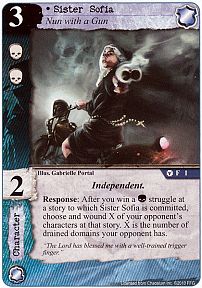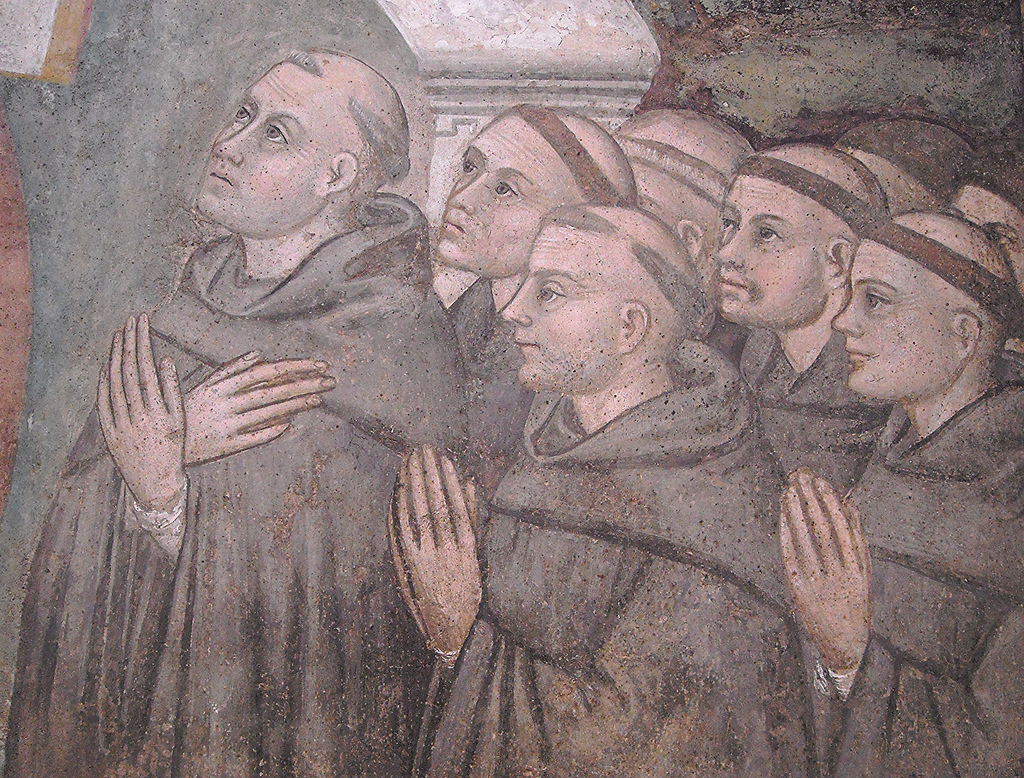

"Have patience, in the way of God"
Author’s Introduction
“Beefing up the Cleric” in issue
#58 of DRAGON™ Magazine
was the first installment in this column in a discussion of the
cleric in the AD&D™ system. This
second installment, brought
about by much urging and assistance from Brad Nystul, will
discuss the non-adventuring cleric. This material is not an
official addition to the AD&D
rules.
The non-adventuring cleric
The regular cleric, according to the AD&D
rules, must have
the following statistics: strength in a range of 6 to 18, intelligence
6 to 18, dexterity 3 to 18, constitution 6 to 18, charisma 6
to 18, and wisdom 9 to 18. (Half-elf clerics must have a wisdom
of at least 13; it might be extrapolated that other demi-human
clerics also must have a minimum wisdom of 13, though halforcs, since
their maximum wisdom is 14, might have their minimum lowered — say, to
11.) If the cleric is not a human, his or
her ability-score minimums and maximums must also be in
accordance with the limits for that race.
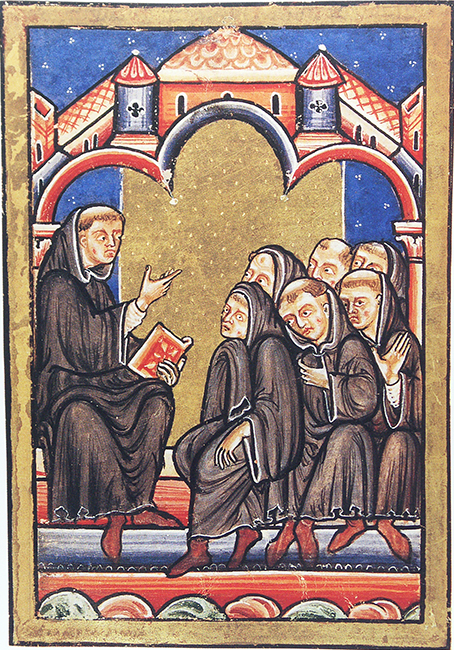
However, one wonders if non-player characters must meet all
the same requirements, especially with regard to the minimum
scores necessary to be a cleric — and, if they are allowed
variation, how they might be “balanced” to retain some advantage for
characters who do meet all the regular requirements.
The AD&D game models its cleric
after the medieval fightercleric, à la Templar or Hospitlar. Yet
we are all aware that all
clerics, then and now, do not meet that standard. The AD&D
game does not take into account scholarly (sometimes called
cloistered) clerics, or brothers who are not ordained but have
some clerical functions. I would like to fill in those two gaps and
allow for regular clerics, as non-player characters, who do not
meet the ability-score minimums for player character clerics.
The easiest group to rule on is those clerics who do not meet
the required minimums in strength, intelligence, dexterity (for
non-humans), constitution or charisma — the minimum wisdom score must
be kept at 9. If the cleric has a low strength,
dexterity or constitution (less than 6), he or she will be at a great
disadvantage in melee: the character will be -1 (or worse) “to
hit” or to damage, +1 (or more) on defensive adjustment, and/or
-1 (or worse) on hit point adjustment. The way to limit such a
cleric is to say that if either strength or dexterity is less than
6,
he or she cannot wield all the weapons permitted to the class.
Such a cleric could use a club, hammer, horseman’s mace, and
staff only. The flail is either too difficult to maneuver or too
heavy; the footman’s mace is too heavy. If strength is less than
6, the hammer can be wielded but not thrown. If both strength
and dexterity are less than 6, the character will fight as a firstlevel
cleric forever — no matter how many levels he or she
might gain in the future.
Non-player character clerics with constitutions of 6 or lower
will tire easily in melee, so that after some number of rounds
they will be -1 “to hit” regardless of strength and/or dexterity.
That number of rounds would be determined by rolling d6 and
adding it to a base number: 4 rounds for a constitution of 6; 3
rounds for a constitution of 5; 1 round for a constitution of 4;
and 0 rounds (use the d6 roll only) for a constitution of 3. Such
non-player clerics might be encountered by a party but they
will usually be part of a local clerical establishment (abbey,
monastery, temple, etc.), or perhaps part of a pilgrimage. They
would not appear as simple “random monsters,” nor would they
ever be found as humanoid shamans. Such non-combatant
clerics, who have full spell ability and other clerical powers,
would likely never rise above the level of Patriarch (8th).
Cloistered clerics
We cannot call these characters “monks” in the AD&D
game,
though that term would be most applicable if we are using
Europe as a model for this type of cleric. The cloistered cleric
(let’s call him or her a friar) will be apart from the outside world
in a monastery, abbey, or other such structure. Some select
friars will be allowed to greet and talk to those who might visit
the monastery. The other friars might not be allowed contact
with the outside world and might be under vows of silence as
well. (They may only speak during church ‘services, in emergencies,
and to convey necessary information.)
The majority (85%) of cloistered clerics will have large libraries
of from 100 to 10,000 books, manuscripts, and scrolls. Cloistered clerics
of at least 9th level with wisdom and intelligence
scores of at least 13 and 15, respectively, and who have a library
of at least 5,000 items, will have the abilities of a minor sage.
They will have sage ability in one Major Field and one Minor
Field only, and no other supporting knowledge whatsoever.
Their percentage chances to know the answer to a question are
as follows:
| - | General | Specific | Exacting |
| In minor field | 36% - 47% (35 + d12) | 21% - 28% (20 + d8) | 9% - 14% (8 + d6) |
| In major field | 51% - 70% (50 + d20) | 35% - 46% (34 + d12) | 16% - 25% (15 + d10) |
Such a cloistered cleric/sage will expect and demand a liberal contribution
to the abbey (church, etc.) of not less than 1,000
g.p. for general information, 2,000 g.p. for specific information,
and 3,500 g.p. for exacting information. There is no fee if the
cloistered cleric/sage does not know the answer to a question.
Cloistered clerics will have the following statistics: Strength,
3-18 (roll 3d6); Intelligence, 6-18 (roll 4d4+2); Wisdom, 9-18
(d10+8); Dexterity, 3-18 (3d6); Constitution, 3-18 (3d6); Charisma,
3-18 (3d6).
Cloistered clerics fight as magic-users, and are allowed the
use of the footman’s mace, the hammer, the club, and the
quarter staff only. They gain only one new weapon, that at 9th
level. They do not wear armor or use a shield but are allowed
rings of protection, cloaks of protection, and bracers of defense.
Their chance of owning such a protection device is 15%
per level, as is their chance of owning a magic weapon. They
are allowed to use any written item allowed to a cleric or a
magic-user, except for those items which would grant them
levels of experience. They may employ potions allowed to clerics or
magic-users (or to all classes) as well as any magic ring.
They may use no rods, staves, or wand except a rod of cancellation,a
rod of resurrection,a staff of curing,and wands of enemy
detection, fear, illumination, and negation.
Cloistered clerics use four-sided dice for accumulated hit
points. They make their saving throws as clerics, but at -2 in all
cases.
They are usually (50%) lawful but might be neutral (35%) or
chaotic (15%). They can be either good (40%), neutral (35%), or
evil (15%) as well.
Cloistered clerics are almost always human, but on occasion
a half-orc or half-elf might be found in their number. Cloistered
clerics have no effect upon undead.
Their possible eventual level is strongly tied to their wisdom
and intelligence scores. Experience-point ranges are not given
for them, since they are always non-player characters.
Note: Cloistered clerics do not gain bonus spells for high wisdom.
Spell list for cloistered clerics
Note: Spells printed in italic
type are from the AD&D
Players Handbook. Those marked “¹” were described
in the Leomund’s Tiny Hut column
in DRAGON #<58>.
Those marked “²” are new spells devised for cloistered
clerics and are described in the following text.
Those marked “³” are reversible spells, but the reverse of the
given spell is not allowed to lawful good
cloistered clerics; likewise, it is 70% unlikely that a
neutral good character will have the reverse spell, and
40% unlikely that a chaotic good cleric will have the
reverse. Those spells containing the word “evil” can be
reversed to either form by lawful neutral or chaotic
neutral clerics.
| 1st Level | 2nd Level | 3rd Level | 4th Level | 5th Level | 6th Level |
| Ceremony (Burial)1 | Augury | Ceremony (Special Vows)1 | Ceremony (Consecrate1 or Desecrate2 Ground) | Atonement | Communcate2 |
| Ceremony (Coming of Age)1 | Ceremony (Dedication)1 | Create Food & Water | Continual Light | Commune | Heal3 |
| Create Water | Ceremony (Investiture)1 | Cure Blindness3 | Detect Lie3 | Cure Critical Wounds | Stone Tell |
| Combine1 | Ceremony (Consecrate Item)2 | Cure Disease3 | Exorcise | Dispel Evil | Word of Recall |
| Cure Light Wounds3 | Chant | Detect Curse2 3 | Neutralize Poison3 | Quest | - |
| Detect Evil | Death Prayer1 | Dispel Magic | Protection from Evil 10' radius | Raise Dead3 | - |
| Detect Magic | Detect Charm | Entrall1 | Speak with Plants | True Seeing | - |
| Hand Fire2 | Detect Life2 | Glyph of Warding (paralysis) | Scroll2 | Ward, major2 | - |
| Magical Vestment1 | Holy Symbol1 | Hold Person | Tongues | - | - |
| Protection from Evil | Know Alignment | Locate Object | Ward, minor2 | - | - |
| Purify Food & Drink | Light | Prayer | - | - | - |
| Remove Fear3 | Slow Poison | Remove Curse | - | - | - |
| Sanctuary | Speak with Animals | Remove Paralysis | - | - | - |
| Scribe2 | Translate2 | Speak with Dead | - | - | - |
| - | - | Dismiss Undead2 3 | - | - | - |
Hand Fire (Alteration)
Level: 1
Range: 0
Duration: Special
Components: V, S
Casting Time: 1 segment
Saving Throw: None
Area of Effect: Cleric’s hand
Explanation/Description: This spell allows the cleric,
by turning his cupped hand upward and saying a command word, to
produce a cold flame that casts the equivalent of torch light.
The hand fire will remain lighted until the cleric casts any other
spell or until he or she uses his or her hand to perform some
other function. The fire is non-harmful and will not ignite any
combustible materials, even oil. It cannot be blown out, but
magical darkness will dispel it instantly
Scribe (Alteration)
Level: 1
Range: Touch
Duration: Permanent
Area of Effect: Variable
Components: V, S, M
Casting time: 1 round
Saving throw: None
Explanation/Description: Via this spell, the cleric’s handwriting, if it happens to be poor, is greatly enhanced.
Furthermore,
he or she can write twice as rapidly as normal and still produce
high-quality copying of a text or map. The scribe spell can be
used when writing down the text of magical scrolls. It further
decreases the chance of error by 25% in the copying of any and
all text. The scribe spell will stay in effect as long as the cleric
continues to copy or compose a text, with a limit of eight hours
of such writing in any case. Any interruption of the copying will
ruin the spell from that point forward. The material components
are ink, quill and parchment (book or scroll) and perhaps that
which is being copied. Note: Magical scrolls cannot be copied
or composed by any cleric below 7th level.
Ceremony
(Bless Newborn) (Abjuration)
Level: 2
Range: Touch
Duration: Six months
Area of effect: One infant
Components: V, S, M
Casting time: 1 turn
Saving Throw: None
Explanation/Description: This spell is used to protect a newborn (within
14 days) infant from possession and other ill effects that might befall
him or her. Such a protected infant gains
a saving throw bonus of +2 from any type of possession. Further, he
or she is under the effect of a half-strength resist fire
and resist cold spell for the full six-month spell duration. The
ceremony of blessing the newborn has no effect upon infants
older than two weeks of age. (Note: usual cost is 2-5 g.p.)
Translate (Alteration)
Level: 2
Range: Self
Duration: 3 turns/level
Components: V, S, M
Casting Time: 1 round
Saving Throw: None
Area of Effect: One text or scroll
Explanation/Description: This spell allows the cleric
to read
texts (scrolls, maps) written in a foreign or alignment language
(including thieves’ cant). It does not allow the reading of magic
or the deciphering of some coded message. The spell can be
used in conjunction with a scribe spell (see foregoing) if the
translation is to be written down. Any scroll containing a spell
or recipe for a potion or powder cannot be translated.
Detect Curse (Divination)
Level: 3
Range: Touch
Duration: Permanent
Area of Effect: One item
Components: V, S
Casting time: 6 rounds
Saving throw: Neg.
Explanation/Description: Via this spell the cleric
can tell
whether an item is cursed, if the item fails a saving throw
allowed to it. The suspect item must be touched by the cleric
and, in some cases, this might release the curse effect. Cursed
scrolls must be opened, but not read, for the spell to have an
effect. Artifacts will not answer to this spell in any case. The
basic saving throw allowed to an item is 13, though very powerful cursed
items will have a saving throw as low as 5 (the DM
must decide the appropriate saving throw on an item-by-item
basis). This spell cannot detect charms; it can detect curses on
persons, though the person is allowed a normal saving throw
versus magic. Casting of this spell will affect the cleric so
strongly that he or she cannot cast any other spells whatsoever
for four hours after this casting, though spells already prayed
for are not lost from memory.
Dismiss Undead (Abjuration)
Level: 3 Components: V, S, M
Range: 6” Casting Time: 2 segments
Duration: 3-12 rounds Saving Throw: Special
Area of Effect: 6” long cone, 2” diam. at base
Explanation/Description: By the casting of this spell, a cloistered
cleric can temporarily gain the ability to possibly turn
undead or command it/them into service. For purposes of determining
success or failure of the turning/commanding attempt while the spell is
in effect, the level of the cloistered cleric
will be that of an adventurer-cleric minus four levels. Thus, a 7th
level cloistered cleric would turn undead as a 3rd level adventurer-cleric.
Undead can be commanded to service by evil cloistered clerics. Neutral
cloistered clerics can only turn (not
command) the undead.
Ceremony (Desecrate
Ground) (Abjuration)
Level: 4
Range: 3”
Duration: Permanent
Components: V, S, M
Casting time: 1 hour
Saving Throw: None
Area of Effect: One building, graveyard, etc.
Explanation/Description: This spell is the reverse of ceremony (consecrate
ground), which was described in DRAGON
issue #58. It may be used by a cleric of any alignment versus a
building or area of ground representing an opposing alignment. For
a building (generally a church or other clericoriented edifice) to be desecrated,
the altar inside must be
covered with holy or unholy water, manure, etc., while the
casting of the ceremony (desecrate ground) is in progress. A
desecrated building is 1% likely per year to collapse; this
chance is not cumulative. Roll at the end of each year of desecration
to see if the structure collapses. A desecrated building
can be consecrated at a later time by application of the unreversed
form of this spell.
If an area of ground (such as a graveyard) is the object of the
spell, it is necessary to know if the ground was consecrated in
the first place. Desecrate groundwill only remove the consecration
if one was in effect. A second, subsequent desecration
has no effect. The area can be reconsecrated. A graveyard that
has never been consecrated is more likely to have its graves
yield lesser undead. If the spell animate dead is cast in such a
graveyard, one extra skeleton or zombie will rise from the
graveyard. Further, any attempt to turn undead in an unconsecrated
graveyard (if and only if the undead come from these
graves) will be as if the cleric were two levels lower than he or
she actually is.
Scroll (Alteration)
Level: 4
Range: Touch
Duration: Permanent
Area of Effect: One scroll
Components: V, S, M
Casting Time: 1 hour
Saving Throw: Special
Explanation/Description: Via this spell, the cleric can compose a magical
scroll of a spell he or she knows with a 40%
smaller chance of error
(see DMG, page <117>). The scroll spell
cannot be used in combination with a scribe spell
(q.v.). Alternatively, the scroll spell can make the cleric write the scroll
faster (double normal speed), but then the reduction in the
chance for an error is canceled.
Ward, minor (Abjuration)
Level: 4
Range: Touch
Duration: Until broken
Components: V, S, M
Casting time: 3 rounds
Saving Throw: Special
Area of Effect: Hemisphere of 15’ radius
Explanation/Description: Via this spell, the cleric brings into
being a special barrier of force. It cannot be physically broken
through by a physical attack of any sort, including the use of
powerful weapons like a vorpal blade. The minor ward, however, can
be brought down by several spells: disintegrate,
limited
wish, phase door, shadow door, plane shift, or wish spell, or any
one of the following spells that does at least 20 points of damage:
fireball, lightning bolt, cone of cold, flame strike, Otiluke’s
Freezing Sphere (second or third application), or meteor
swarm. Anything within the hemispherical area of effect is not
damaged when the minor ward is brought down (but might be
put in jeopardy). The minor ward cannot be entered or exited by
traveling astrally, or via dimension door, passwall,or teleport.
Characters and creatures in the hemisphere cannot cast spells
out, though spells can be cast so as to affect those inside the
minor ward, such as cures, neutralize poison, commune, etc.
The minor wardwill remain in effect as long as the cleric is
conscious; in the round after he or she falls asleep or is knocked
unconscious (or worse), the ward will collapse. The caster can
will it to come down at any time, but this act takes 1 full round.
To effect the spell, the cleric must space seven small pearls (at
least 100 g.p. value each) evenly on the ground in a 30-footdiameter
circle. Smaller circles can be made, if desired, but
never larger ones. The pearls are consumed in the casting.
Communicate (Divination)
Level: 6
Range: Unlimited
Duration: 1 turn + 1 rd/level
Components: V, S, M
Casting Time: 3 rounds
Saving Throw: None
Area of Effect: Caster and one other person
Explanation/Description: Via this spell, a cleric can communicate with
another person anywhere on the Prime Material
Plane.
He or she casts the spell using a mirror as a material
component. The person to be contacted must be known to the
cleric, and the subject cannot be within any type of force field
like a cube of force, minor ward, major ward, major or minor
globe of invulnerability, etc., nor may the contacted person be
under the protection of a mind blank spell or a psionic defense
like tower of iron will. The subject, if asleep, will awaken if that
person makes a saving throw versus magic (a new saving throw
is allowed every other melee round). Once contact is established the
cleric can see, if the subject is willing, whatever that
person can see, and vice versa. Hearing is also allowed, so
someone speaking to the cleric or person can be overheard —
but the words must, of course, be repeated for others to have
knowledge of them.
The communication link is so strong that the cleric can cast a
curing spell of any type through the link to the person being
contacted. Once the cure is so cast, the link breaks immediately. The
cleric who casts the cure spell can do no further spell
casting for one full day plus one additional day for each level of
the cure cast through the communication. The receiver, who
may be of any character class, has no way to contact the cleric,
although prearranged contacts are certainly possible.
Contact established by means of this spell while the subject
is occupied (casting a spell or involved in melee, for instance)
will require that the receiver stop pursuing the current activity
in order to accept the communication. The cleric can only
communicate with, or look in on, someone who is willing and
doing nothing else at the time. If this is not the case, the cleric
will realize the communication has been rejected, for a reason
which may not be known to him or her, and the contact will
break. The cleric will see or hear nothing through the subject’s
senses if that person rejects the communication.
The life of the cloistered cleric
The cloistered cleric is both literate (if his or her intelligence
is 6 or above) and can write.
The character spends most of his
or her time studying or copying texts and scrolls. He or she may
also have mundane duties to perform, and some groups of
cloistered clerics do not exempt even a Dean from such duties.
The abbey or monastery where the cloistered cleric resides is
almost always (90%) made of stone and is usually (60%) surrounded by
a wall of stone as well. Farm lands tended by the
cloistered clerics surround the abbey or monastery. Most abbeys and
monasteries exist outside of towns, and many are well
away from main roads. Only cloistered clerics involved in
teaching will have residence in a town or city. These teachers
will run schools and colleges, and such an individual’s library
will have a minimum of 2,500 scrolls and/or books.
The abbey or monastery never has fighting clerics or monks
in it, nor are fighting clerics or monks ever employed on a
permanent basis by cloistered clerics. For their own protection,
in hostile territories, abbeys or monasteries may have in their
employ men-at-arms (if evil, humanoids of one hit die or less)
headed by a fighter (but not a
ranger or a paladin) of 1st to 7th
level. (A fighter of 3rd or higher level may have from 1-6 sergeants
or even 1 lieutenant to aid him or her.) Cloistered clerics
do not hire a thief or assassin, unless to recover some item
stolen from them. A magic-user or sage occasionally may be in
temporary residence in an abbey or monastery, doing research
(15% and 3% likely, respectively).
Learning and recovery of spells
Cloistered clerics have one important difference in the way
they gain and use their spells. They must rest for the appropriate
time, as any other spell caster. They then must pray for a
period of not less than one hour per level of the highest level
spell that they will memorize; i.e., an Archimandrite would have
to pray to his or her deity for six hours to replace his or her 6th
level spell, but could also replace any first to fifth level spells
as
well after this period. Once the cloistered cleric has prayed, he
then reads the desired spell from a spell text, just as a magicuser
does, taking 15 minutes per spell level per spell. He or she
does not have to roll a percent chance to “know” a spell in any
case, but he or she must have the minimum intelligence and
wisdom as outlined earlier! All
cloistered clerical spells are
written in large tomes as large as magic-user spell books. They
are written in a language which, while it can be learned by
another cleric, will never give spell power to any other type of
spell caster including a druid.
An adventuring cleric who knows the language of cloistered
clerics can read from their texts to learn a spell. This process
will take the adventuring cleric 30 minutes per spell level per
spell and in no way counts as a spell known to that adventuringclass
cleric. Further, if a given spell is not available until a
higher level to a cloistered cleric, it must be memorized by an
adventuring class cleric at that (higher) level. The adventuringclass
cleric must also pray to his deity, just as the cloistered
cleric must, before the book or text will release its power from
the written word. A cleric who does not pray prior to reading will
gain nothing from the text. Example: A 5th level adventuring
cleric (a Prefect) wants to read hold person from a cloistered
cleric’s book of spells. For the cloistered cleric this is a third
level spell, so the adventuring cleric must pray for three hours
and then read the spell text, memorizing it as a third level spell,
in the next one and half hours. (The cloistered cleric would only
take 45 minutes to read the same spell.) If the adventuring cleric
has not learned the prayer for hold person before, the character
may not now pray to his or her deity for it, even though he or she
has just memorized it. Cloistered clerics usually only have one
or two spell books in their abbey or monastery, and thus they
will not willingly part with a book, even a duplicate.
Cloistered clerics are very poor, using any wealth they may
gain only to pay for food, clothing and items used in the abbey,
monastery, or school. Even their altar wear is usually plain, as
are the altar pieces and church/temple decorations. What monies they
do collect from donations and spell casting — they
always charge for spell casting — may be divided up and sent to
other temples, churches, abbeys, etc.
Brothers
Brothers are clerics who are not
ordained. They have func
tions around and about the church/temple, but often have a
second occupation totally unrelated to the church (shopkeeper, blacksmith,
housewife, etc.). A brother or sister (not the
same as a nun) might also be a teacher, scholar, moneyhandler, assistant
in the service, and so forth. His or her secondary profession might allow
the character to be trained with a
weapon; in fact, the brother or sister might be an adventuringclass
character of some type.
Fully 60% of all brothers and sisters have no education in
fighting. They would be unarmored and 50% likely to be unarmed as well.
Those who do bear arms might carry a dagger
(unless their organization forbids it), a short sword (again,
some organizations might not allow edged weapons carried by
any clerical figure), club, mace, quarter staff or hammer. They
would fight as zero-hit-dice figures but would obtain the saving
throws of a first level cleric in all categories, because of their
religious training.
The balance of brothers and sisters (40%) will have some
weapon skills. Those weapon skills are apart from any secondary profession.
These brothers and sisters can don armor in
times of strife, wearing leather or studded leather most often
and occasionally bearing a shield as well. They fight as first
level clerics and obtain the same saving throws. They will have
one eight-sided die for their hit points (the non-fighting brother
and sister will use a six-sided die, as all zero-level figures do).
The weapons allowed to them are as a cleric, but some might
bear daggers, short swords, or broad swords as well. None of
these brothers and sisters, in either category, ever obtain more
hit points, nor do they ever become better at melee.
Brothers and sisters may also be deacons in the
organization.
One in four brothers will be a deacon, and a congregation with
more than four deacons will have an archdeacon as well. Archdeacons
and deacons are allowed two and one first level clerical spells, respectively,
per day. (They cannot re-pray for their spell after four hours of rest
like a first level cleric).
The list of spells available to archdeacons and deacons is
limited to these only: bless, cure
minor wounds (works as cure
light wounds but does only 1d4 of healing), detect evil (might
be reversible in some organizations), endure cold, endure heat,
purify food and drink, remove fear, and sanctuary.
Endure heat and endure cold are generally only known in
areas where extremes of heat and cold are in fact present.
Remove fear cannot be reversed to cause fear, and purify food
and drink cannot be reversed to putrefy food and drink. Some
organizations might allow the reverse of cure minor wounds to
cause minor wounds if the organization is evil or chaotic neutral,
or if there is great need and the temple or church might fall
if the spell is not made available to its deacons and archdeacons.
Brothers and sisters otherwise will be found in most churches
and temples and occasionally in abbeys, monasteries, and
schools. They will likely not reside on the organization’s property.
They will perform mundane duties in most cases (washing
floors, cooking, cleaning the temple or church — though rarely
the altar and other services) — but some, as mentioned earlier,
will be scholars and teachers. A deacon is of equal rank to an
Acolyte or Novice, but an archdeacon is superior to an Acolyte
or Novice. Brothers and sisters do not go into battle unless the
church or temple, or the town in which it is located, is threated
with destruction. They surely do not adventure and do not go
into dungeons. If a deacon or archdeacon administers a cure
minor wounds spell, he or she can expect 40 g.p. from a
stranger for the spell. He or she might cast this spell for free on
the members of the church’s congregation.
If the reader would like to study the fantasy cleric, both the
adventuring and non-adventuring types, he or she might wish
to read the Camber of Culdi trilogy by Katherine Kurtz (Del
Rey
Books) or the Chronicles of the Deryni (Del Rey Books) Note:
The Legends of Camber of Culdi is a prequel to the Chronicles
of the Deryni.
A regular cleric according to the AD&D
game rules, must have
the following stats: Str in a range of 6 to 18; Cha, 6 to <check
this>
18; and Wis, 9 to 18. (Half-elf clerics must have a Wis of at
least 13; it might be extrapolated that other demi-human clerics also
must have a min. Wis of 13, though half-orcs, since their
max. Wis is 14, might have their min. lowered -- say,
to 11.) If the cleric is not human, his ability scores must also be
in
accordance with the limits for that race.
However, one wonders if NPCs must meet all the
same requirements, esp. with regard to the min. scores
necessary to be a cleric -- and, if they are allowed variation,
how
they might be "balanced" to retain some advantage for characters
who do meet all the regular requirements.
* Not likely to rise above this level.
1. SUBCLASS = cleric
2. SOCIAL CLASS MINIMUM =
3. ABILITY SCORE MINIMUMS
STRENGTH = 3*, **, *** (3-18 : 3d6)
INTELLIGENCE = (6-18 : 4d4 + 2)
WISDOM = 9 (9-18 : d10 + 8)
DEXTERITY = 3*, *** (3-18 : 3d6)
CONSTITUTION = 3 **** (3-18 : 3d6)
CHARISMA = (3-18 : 3d6)
COMELINESS =
PERCEPTION =
4. XP BONUS =
5. POSSIBLE RACES & MAX. LEVEL ATTAINABLE = almost always human.
half-orcs or half-elves possible.
6. MULTI-CLASS POSSIBILITIES =
7. HIT DIE TYPE = d4
8. MAXIMUM NUMBER OF HIT DICE =
9. SPELL ABILITY =
10. ARMOR PERMITTED = no
11. SHIELD PERMITTED = no
12. WEAPONS PERMITTED = footman's mace, hammer, club, quarterstaff,
*, **
13. OIL PERMITTED =
14. POISON PERMITTED =
15. ALIGNMENT = 50% lawful, 35% neutral, 15% chaotic. 40% good, 35%
neutral, 15% evil.
16. STARTING MONEY = 15% chance per level to own a protective device,
15% chance per level of owning a magic weapon
17. WEAPON PROFICIENCIES = one at 1st, one at 9th, no more after that.
18. NON-PROFICIENCY PENALTY =
19. NON-WEAPON PROFICIENCIES =
20. STARTING AGE =
21. COMBAT = MU, ***
22. SAVING THROWS = cleric-2
23. MAGIC ITEMS = rings
of protection, cloak of protection, bracers of defense.
Any written item allowed to a cleric or MU (or to all classes), but
no items which would grant them levels of experience.
Potions allowed to clerics or magic-users (or to all classes) as well
as any magic ring.
No rods, staves or wands, except for:
rod of cancellation, rod of resurrection, staff of curing, and
wnad
of enemy detection, wand of fear, wand of illumination, and
wand
of negation.
* If Str or Dex is less than 6, then the cloistered cleric can only
wield a club, hammer, horseman's mace, and staff only.
** If Str is less than 6, the hammer can be wielded, but not thrown.
*** If both Str and Dex are below 6 the character will fight
as a 1st-level cleric forever.
**** If Con is 6 or less, then roll d6+x (x=4 if Con=6, x=3 if Con=5,
x=1 if Con = 4, x=0 if Con=3)
Compare to: Cleric
16. WEAPON PROFICIENCIES = 2, 1 per 4 levels
(1st: 2, 5th: 3, 9th: 4, 13th: 5, 17th: 6, 21st: 7, 25th: 8, 29th: 9)
17. NON-PROFICIENCY PENALTY = -3
18. NON-WEAPON PROFICIENCIES = 3, 1 per
4 levels (1st: 3, 5th: 4, 9th: 5, 13th: 6, 17th: 7, 21st: 8, 25th: 9, 29th:
10)
I'd recommend 6 NWPs at L1, with 1 per 2 levels thereafter.
A regular cleric according to the AD&D
game rules, must have
the following statistics: strength in a range of 6 to 18; charisma,
6 to
18; and wisdom, 9 to 18. (Half-elf clerics must have a wisdom of
at
least 13; it might be extrapolated that other demi-human clerics
also
must have a minimum wisdom of 13, though half-orcs, since their
maximum wisdom is 14, might have their minimum lowered -- say,
to 11.) If the cleric is not human, his ability scores must also
be in
accordance with the limits for that race.
However, one wonders if NPCs must meet all the
same requirements, esp. w/ regard to the min. scores
necessary to be a cleric -- and, if they are allowed variation,
how.
they may be "balanced" to retain some advantage for characters
who do meet all the regular requirements.
"The majority (85%) of cloistered clerics will have large libraries of from 100 to 10,000 books, manuscripts, and scrolls."
zb
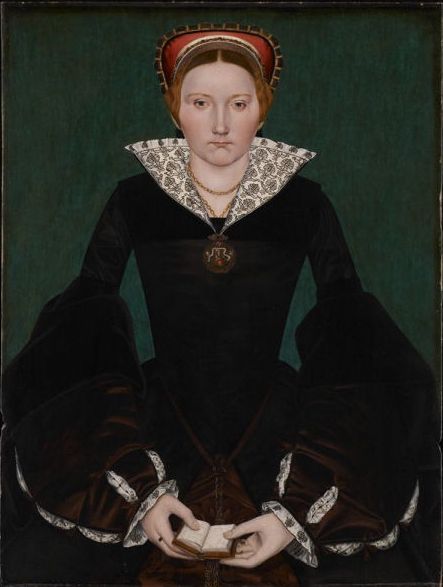
ROGUES GALLERY: CLOISTERED CLERICS
Friar Barley (thanks: Robert Krampen)
Father Palmer (thanks: Tony Malocca)
Father Fenris the Tickler (thanks: Demian Haas)
Father Ohmahgod (thanks: Lew Matthews)
Father (thanks: Jordan Nettum)
Sister Golden Hair (thanks: Steve
Eutzy)
Brother Frumanuddermudder (thanks: Ron Huff)
Deloris Van Cartier (Whoopi Goldberg's character in Sister Act)
(thanks: Ben SG Johnstone)
Mother Theresa (thanks: Ben SG Johnstone)
Padre Praetor, the Predator Pedo (thanks: Mike Merry)
11.
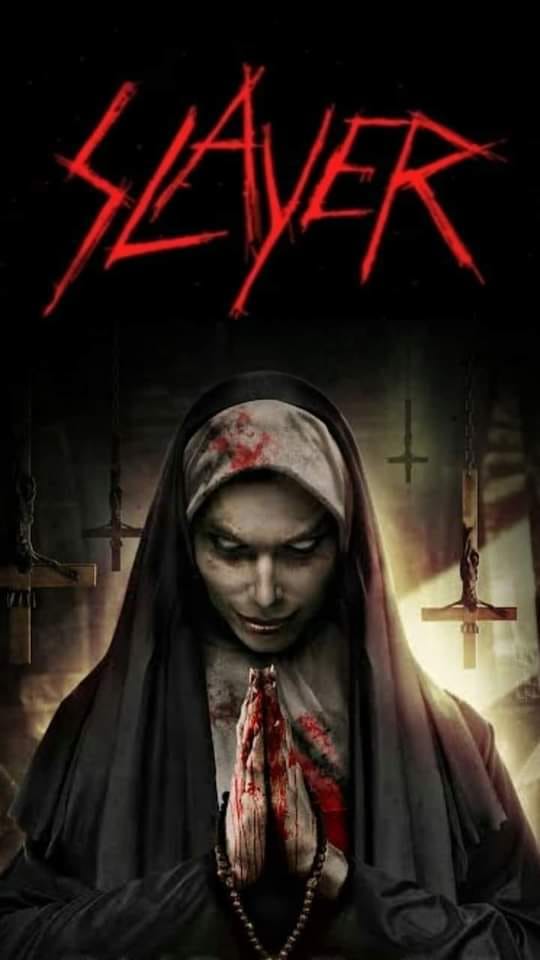
-
10.
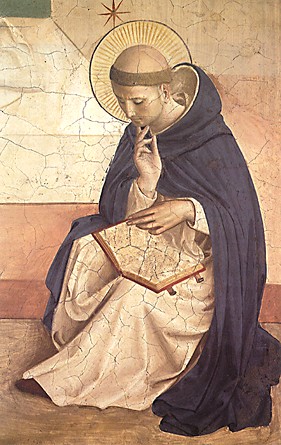
9.
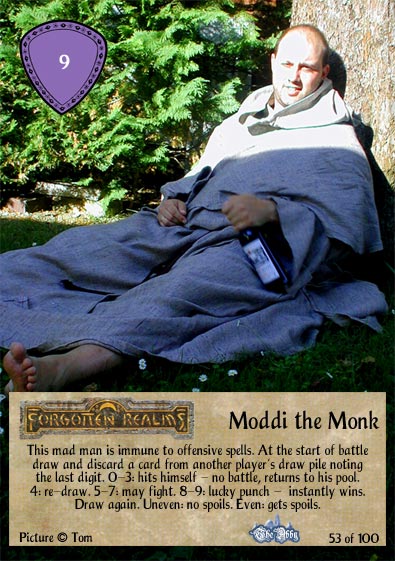
8.
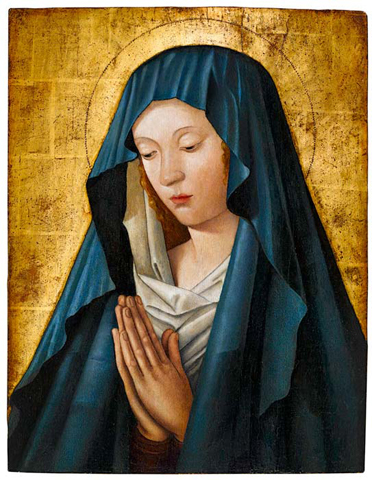
7.
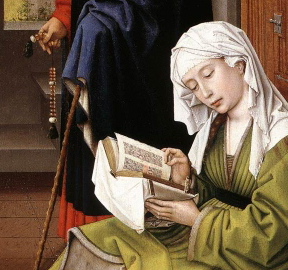
6.
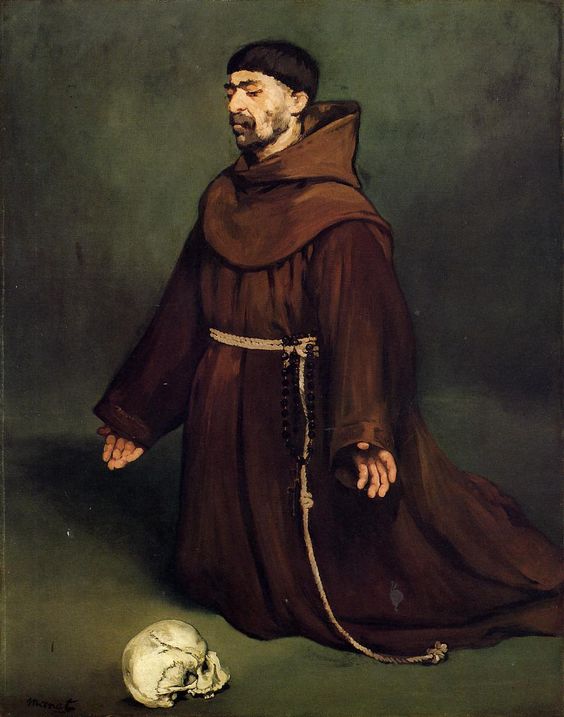
5.
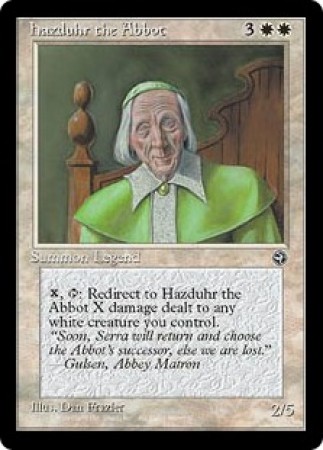
4.
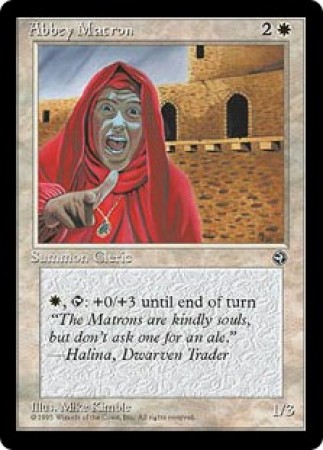
3.
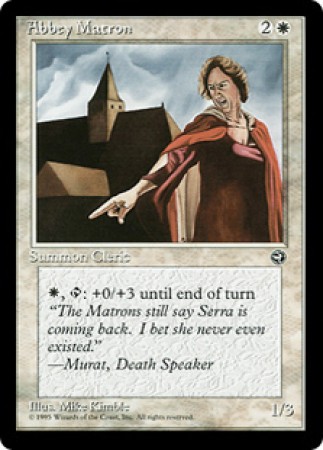
2.
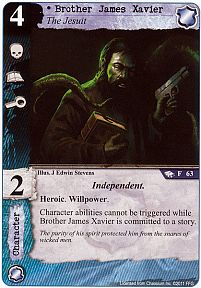
1.
